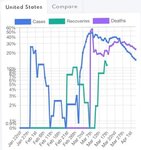Hecaviator
Active member
https://covid19.healthdata.org/projections
Projections updated...
Projected total deaths down to 80k. And it also predicts a much sooner end to the outbreak.
I truly hope the lower projections you cite pan out, but caution might be advised for several reasons:
1. The epidemiological models I've been able to find and read about on line are based on assumptions of preemptive and mitigation measures that may or may not be applied or maintained. It is hard to factor in the uncertainties evident in the current climate where there is no centralized (federal) management of such measures in the USA. It is still pretty much the Wild West in terms of policies and practices.
2. Models use data. Beware of garbage in - garbage out. The reporting of confirmed cases and deaths by the various states and local governments in the USA is probably better than much of the data coming in from around the world. (There are a lot of questions to be raised about the reporting and data from other parts of the world. Some of it just doesn't make sense.) There is likely to be some garbage involved in the data here in the USA. At this point, it's just a question of how much and how quickly it can be weeded out.
3. Testing in the USA has been an abysmal failure so far. Contact tracing, and sustained follow up beyond initial tracing, isn't any better in most states. For that matter, with a few exceptions like Germany and New Zealand, testing and derivative measures like contact tracing in other parts of the world hasn't been very good either. That has a direct bearing on the problem of garbage in - garbage out when modeling. Even the experts don't have a clear idea what they are dealing with, as admitted by Dr. Fauci. I think the word he used is "struggling". We used to call this situation WBG - we be guessin'. Not a pretty thought when you consider the situation we're in. Like I noted previously, you can't manage what you can't measure.
4. What data is being widely reported (e.g., the John Hopkins U. reporting), appears to be based solely on "confirmed" infections and deaths. It is reported by various sources. That may inject another wildcard into the modeling, the reliability of those sources. We don't know what quality control is being applied to the data sources. It also ignores the 800 lb gorilla in the room: there doesn't seem to be anything credible regarding the extent of unconfirmed cases. Given that some unknown portion of those persons infected are asymptomatic (and therefore aren't getting tested), but are capable of passing on the virus to others without knowing it, you have a hidden component of the overall infection rate. That will likely sustain the spread of the virus to some unknown degree. That is totally speculative, but could potentially increase the peak and lengthen the curve. It basically blinds the modeling, i.e., unless someone has figured out what the unconfirmed incidence of infections is with some reliability, the model has a blind spot. That hidden portion of the total extent of infection is coupled with the testing debacle, and won't get resolved until testing can be statistically reconciled to account for both confirmed and unconfirmed infections. That can only be done by testing in numerous geographical regions, not one or two. You wouldn't want to model based only on Wyoming or only on New York City. Trying to apply tailored modeling to all of the states individually (or to local areas) without statistical accounting of the "unconfirmed" incidence of infection is a big ask. Maybe that uncertainty is fully reflected in the broad ranges shown in the modeling. Maybe not.
5. Treatment via a new vaccine or use of other drugs is uncertain and very speculative in terms of timing and effectiveness. Any reliable and properly validated vaccine is probably not just over the horizon, which is why none of the models I've seen account for it in any way. I suppose we can hope for a miracle, though that would seem to be intruding on the space already preempted by the federal government.
IMO, this has been a total cluster up to this point and seems likely to continue for a while. All we can really do is be kind to each other and hang on. And at least do what Drs. Fauci and Birx suggest.














